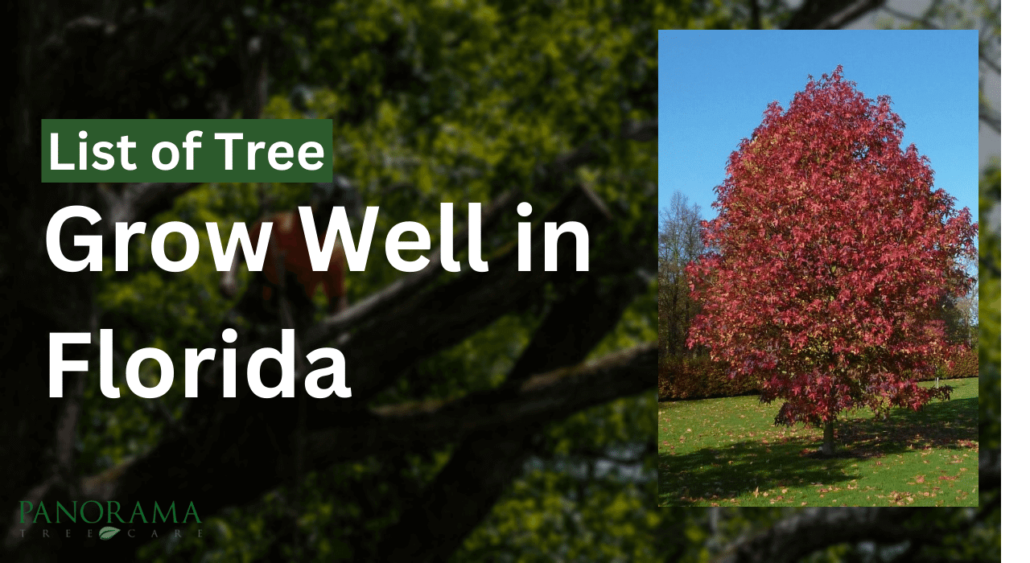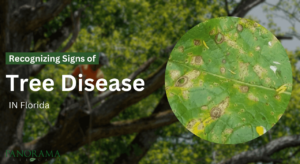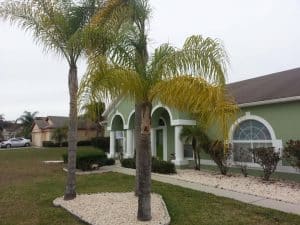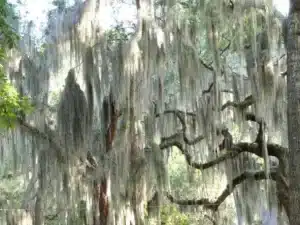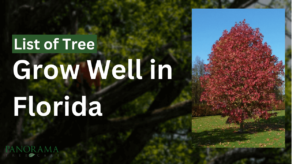When it comes to landscaping in Central Florida, choosing the right trees is crucial for creating a thriving, low-maintenance outdoor space.
The region’s unique climate, characterized by hot, humid summers and occasional freezes, can pose challenges for certain tree species.
That’s why it’s essential to select trees that are well-adapted to these conditions, ensuring they not only survive but flourish in your yard.
Native Trees of Florida
Native trees are those that occur naturally in the region.
They are well-adapted to the local climate and soil conditions, making them a low-maintenance option for gardeners.
Additionally, they play a crucial role in supporting local ecosystems by providing habitats and food for wildlife.
Live Oak (Quercus virginiana)
The Live Oak is a symbol of strength in the southern landscape, known for its vast canopy that provides extensive shade.
This makes it an excellent choice for large spaces needing shade. Its ability to withstand both dry and wet conditions, along with its resistance to the occasional cold, makes it ideal for Florida.
Live Oaks also play a critical role in local ecosystems, supporting a variety of wildlife from birds to squirrels.
Bald Cypress (Taxodium distichum)
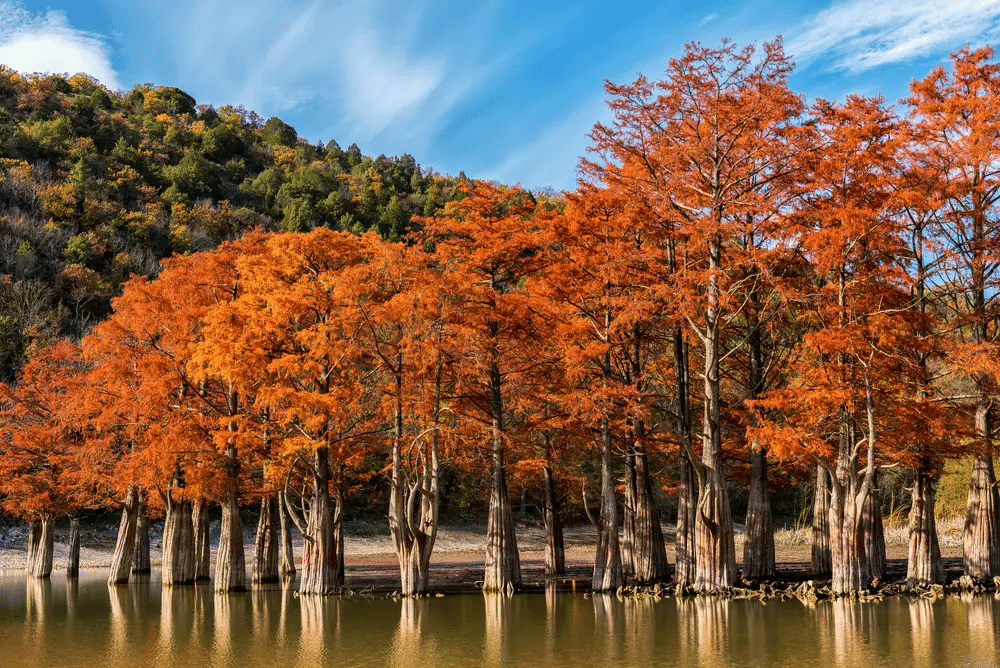
The Bald Cypress is unique, thriving in wet conditions, making it perfect for areas near water bodies or with poorly drained soil.
Despite its preference for moisture, it can surprisingly tolerate drought once established.
The tree is noted for its distinctive conical shape, feathery foliage, and the intriguing “knees” it develops in wet conditions—structures thought to help the tree with stability and oxygen supply.
Red Maple (Acer rubrum)
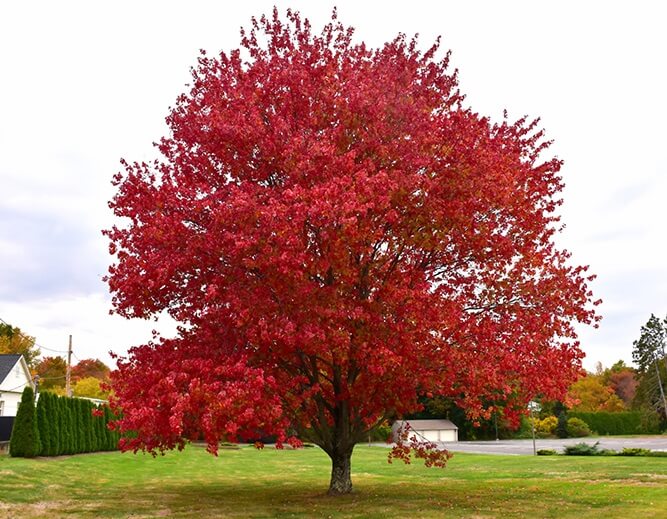
The Red Maple brings a splash of color to the Central Florida landscape, especially in the fall when its leaves turn a vibrant red.
It’s a versatile tree that can adapt to a variety of soil types, though it prefers slightly acidic, moist conditions.
The Red Maple is relatively fast-growing, making it a popular choice for adding color and shade to landscapes in a shorter time.
Sweetgum (Liquidambar styraciflua)
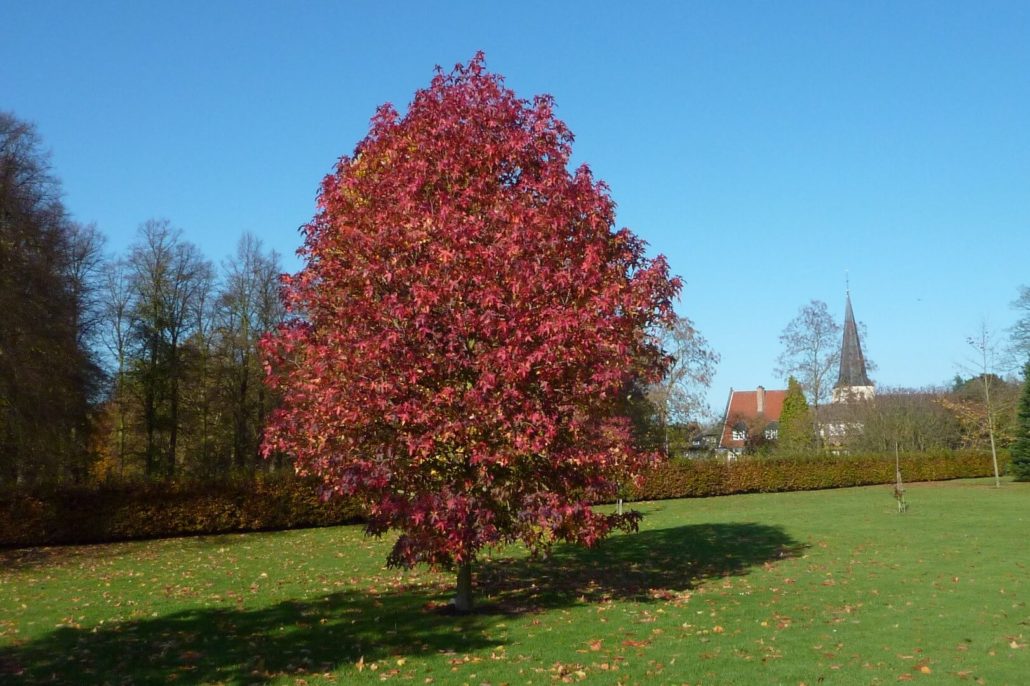
Sweetgum is recognizable by its star-shaped leaves that turn magnificent shades of red, orange, and yellow in the fall.
It’s a valuable addition to any garden looking to add fall color to the mostly evergreen backdrop of Central Florida.
While the tree’s spiky balls might be considered a nuisance by some, they provide food for wildlife and can be collected for craft projects.
Crape Myrtle (Lagerstroemia)
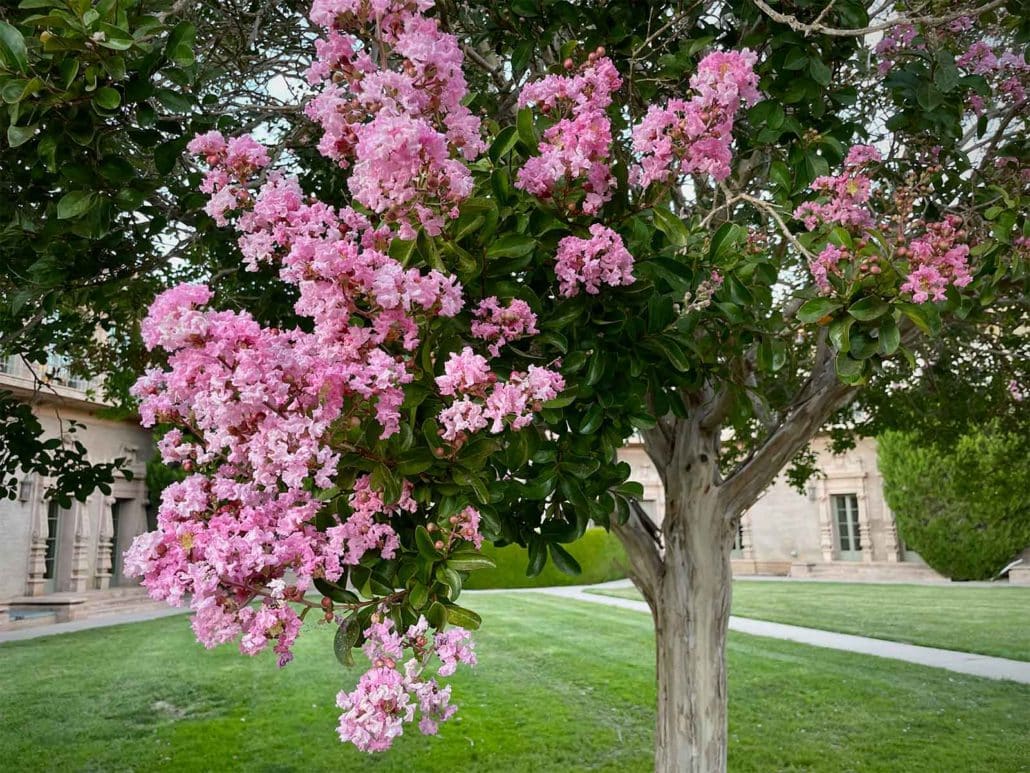
Though not originally from North America, the Crape Myrtle has become naturalized in many parts of the South, including Central Florida, where it’s valued for its drought tolerance and long-lasting blooms.
Available in a range of colors, from pink to red to white, these trees can provide a vibrant display for much of the summer and into the fall.
Crape myrtles are relatively small, making them suitable for urban gardens or as a focal point in larger landscapes.
Drought-Tolerant Trees
Given Central Florida’s propensity for dry spells, incorporating drought-tolerant trees into your landscape is a wise decision.
These species can thrive with minimal water, making them ideal for the region’s sometimes harsh conditions.
Southern Magnolia (Magnolia grandiflora)
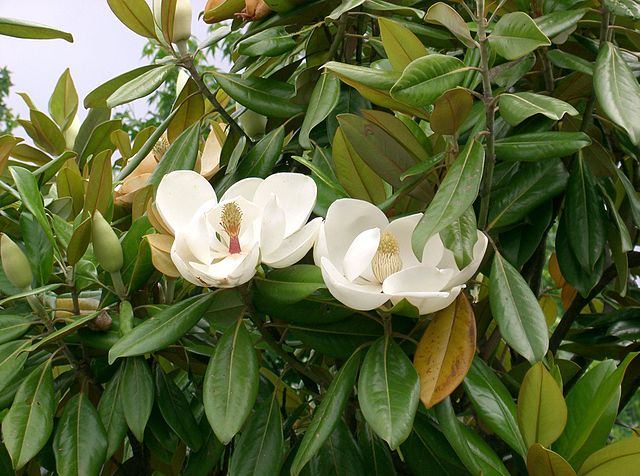
The Southern Magnolia is a classic symbol of the southern United States, beloved for its large, glossy leaves and massive, fragrant white flowers that bloom in late spring and early summer.
This tree’s ability to withstand dry spells once established, combined with its evergreen foliage, makes it an excellent choice for year-round interest and privacy screens in Central Florida gardens.
Its resilience and low water needs after the initial establishment period fit perfectly with the regional climate.
For trees like the Southern Magnolia and Live Oak, regular maintenance is essential.
Ligustrum (Ligustrum spp.)
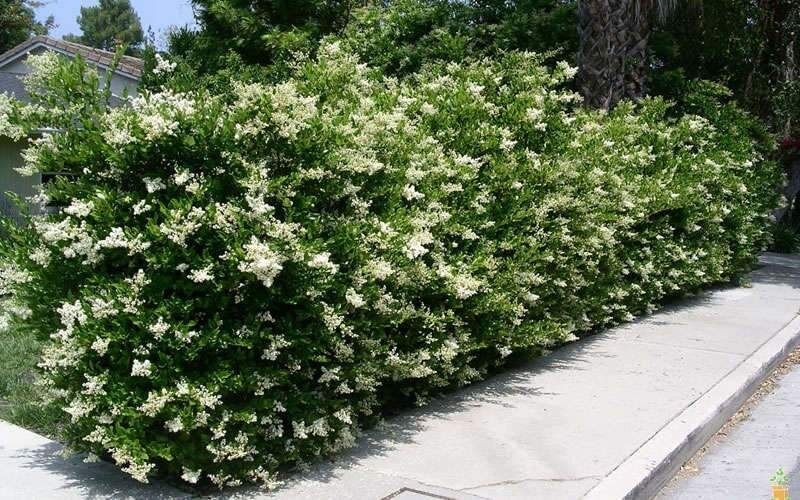
Ligustrum, or privet, encompasses a variety of species, many of which are drought-tolerant once established.
These trees or shrubs are highly adaptable, featuring dense foliage that can be pruned into formal shapes, making them ideal for hedges or privacy screens.
Their versatility and ease of care have made them a popular choice in many Central Florida landscapes.
However, it’s important to choose a non-invasive species, as some types of Ligustrum can spread aggressively.
Pongam (Pongamia pinnata)
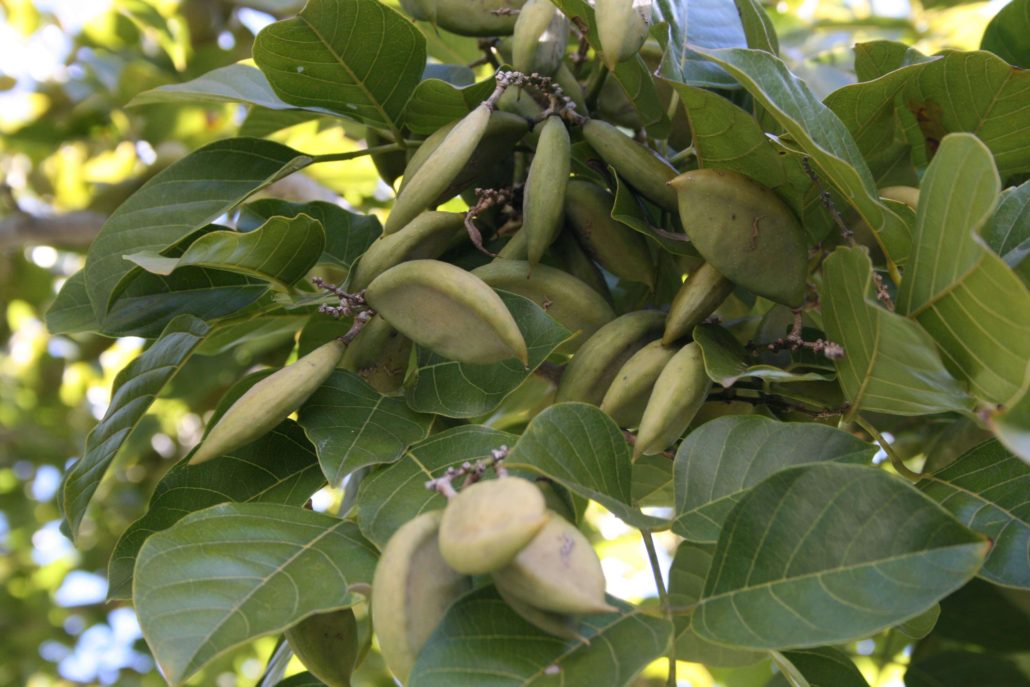
Pongam, also known as Millettia pinnata, is a relatively less known but highly resilient tree.
It produces beautiful clusters of pink and purple flowers that add a splash of color to any landscape.
Besides its drought tolerance, Pongam is appreciated for its fast growth and adaptability to a wide range of soil types.
Its hardy nature makes it suitable for urban environments where heat and limited water can stress less adaptable species.
Pithecellobium (Pithecellobium dulce)
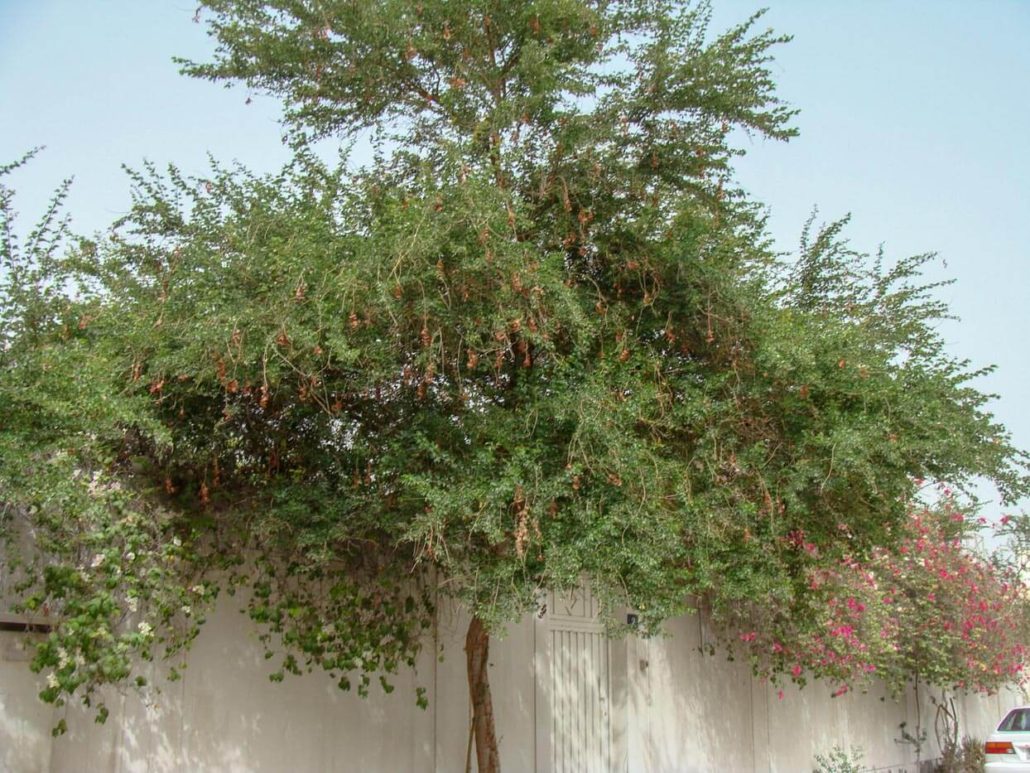
Often referred to as the Sweet Tamarind or Manila Tamarind, Pithecellobium is notable for its unique, twisted trunk and bright, puffball flowers that attract pollinators.
This tree is highly tolerant of drought conditions once it’s well-established and can thrive in a variety of soil types, including those of lower quality.
Its fruit is edible and often used in traditional dishes in its native range, adding an extra layer of interest for homeowners.
Tabebuia (Tabebuia spp.)
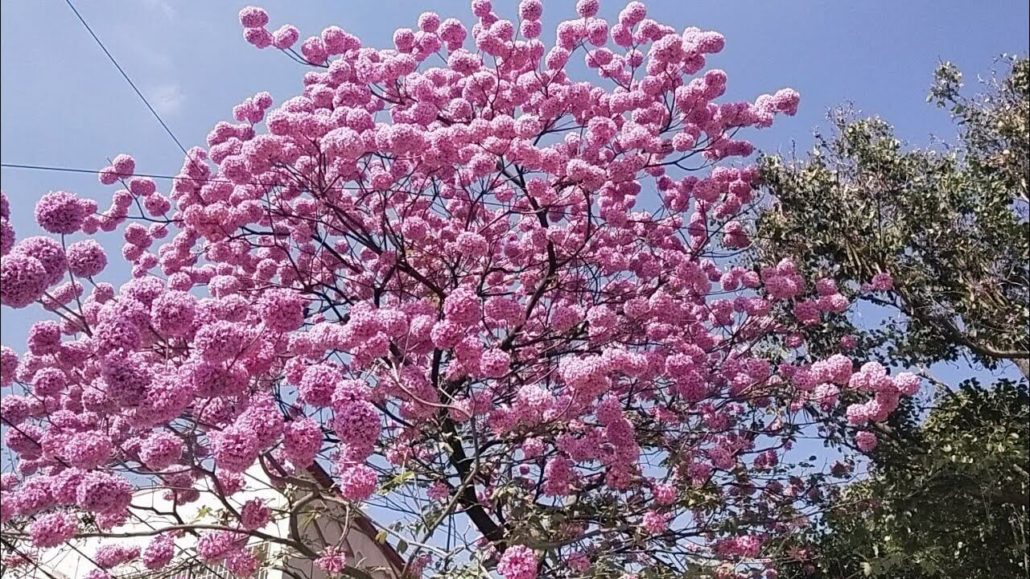
Tabebuia trees, with their vibrant blooms of yellow, pink, or lavender, herald the arrival of spring in Central Florida.
These trees are not only a visual delight but also highly drought-resistant once established.
They prefer well-drained soils and full sun, making them ideal for sunny spots in the landscape that other species might find challenging.
Tabebuia trees are relatively slow-growing, which makes them suitable for both small gardens and as specimen trees in larger landscapes.
Shade Trees for Central Florida
Shade trees are invaluable in Central Florida, providing relief from the intense sun and helping to reduce energy costs by cooling homes and gardens.
Laurel Oak (Quercus laurifolia)
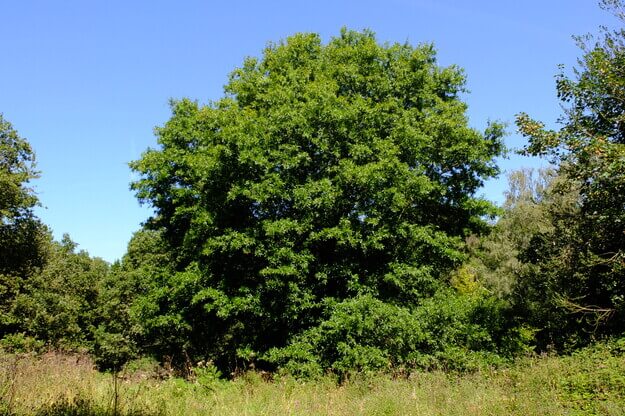
The Laurel Oak is a fast-growing shade tree native to the southeastern United States, making it well-suited to the climate of Central Florida.
It can provide a large, dense canopy relatively quickly, offering significant shade over lawns, patios, or other outdoor living spaces.
This oak variety prefers moist, well-drained soils but can adapt to different soil types, showcasing its versatility.
One of its standout features is its ability to grow in both sunny and partially shaded conditions, allowing flexibility in garden design.
However, homeowners should be mindful of its size at maturity and potential for limb drop, making it more suitable for larger properties.
Sycamore (Platanus occidentalis)
The Sycamore tree, with its distinctive mottled bark that peels away to reveal creamy white and green underneath, is a striking addition to any landscape.
It’s known for its broad, green leaves that provide ample shade, making it an excellent choice for Central Florida homes needing relief from the sun.
Sycamores are robust trees that can grow in a variety of soil conditions, including wet soils, and they thrive in full sun.
They can reach great heights, so they’re best planted in spaces where they have room to expand.
Besides their shade-providing capabilities, Sycamores are valuable for their ability to improve air quality by absorbing pollutants.
Winged Elm (Ulmus alata)
The Winged Elm is named for the unique corky growths that appear along its branches, resembling wings.
This medium-sized tree is adaptable and tough, capable of growing in a wide range of soil types, including those that are dry or poorly drained, making it a versatile choice for Florida landscapes.
It provides a good amount of shade with its dense foliage, making it suitable for planting in residential gardens or parks.
The Winged Elm is relatively low-maintenance and can tolerate urban conditions, including pollution and limited space, making it an excellent choice for city landscapes as well.
Mahogany (Swietenia mahagoni)
Although not native to Central Florida, the Mahogany tree has adapted well to the region’s climate. Prized for its beautiful, durable wood and dense canopy, Mahogany trees offer deep shade, making them valuable in hot climates.
These trees are somewhat salt-tolerant, which can be an added benefit in coastal areas of Central Florida. They require well-drained soils and a position in full sun to thrive.
While slower growing compared to some other shade trees, Mahogany trees are long-lived, providing beauty and shade for generations.
Due to their size and root system, they’re best suited for larger landscapes where they have room to grow without interfering with structures.
Low-Maintenance Trees
For those who prefer a beautiful landscape but have little time or expertise in gardening, low-maintenance trees are a perfect choice.
Crape Myrtle (Lagerstroemia spp.)
The Crape Myrtle is celebrated for its spectacular summer blooms that come in a wide range of colors, including pink, red, purple, and white.
Beyond its visual appeal, the Crape Myrtle is incredibly low-maintenance once established. It prefers full sun, which is abundant in Central Florida, and well-drained soil.
While it benefits from occasional pruning to encourage blooming and maintain shape, this is not strictly necessary for the tree’s health or survival.
Its ability to withstand drought, once established, makes it an ideal choice for the region’s varying weather patterns.
The Crape Myrtle’s resilience to pests and diseases further underscores its low-maintenance nature, making it a worry-free addition to any landscape.
Ligustrum (Ligustrum spp.)
Ligustrum, or privet, is another low-maintenance tree well-suited to Central Florida’s climate.
This versatile tree can be used as a standalone specimen, in groupings, or even trimmed into formal hedges or topiaries, offering aesthetic flexibility with minimal effort.
Ligustrum thrives in full sun to partial shade and can adapt to a variety of soil conditions. It’s particularly noted for its rapid growth and dense foliage, which provides privacy and sound buffering with minimal upkeep.
Regular trimming can keep it in shape, but this is more about aesthetics than necessity. Its drought tolerance, once established, minimizes the need for watering, and it’s generally resistant to pests and diseases, further reducing the need for care.
Southern Magnolia (Magnolia grandiflora)
The Southern Magnolia is a quintessential Southern tree, valued for its large, fragrant white flowers and glossy evergreen leaves.
This tree is a standout for its beauty and the minimal care it requires once established. It prefers full sun to partial shade and well-drained soil but is adaptable to a range of soil conditions.
The Southern Magnolia is drought-tolerant, reducing the need for frequent watering. While it can grow quite large, its slow growth rate means that it doesn’t require frequent pruning.
This tree’s evergreen nature ensures year-round beauty with little effort, making it an ideal choice for those seeking a low-maintenance yet striking landscape feature.
Pongam (Pongamia pinnata)
Pongam, sometimes known as the Pongamia tree, is notable for its beautiful and fragrant flowers, along with its ability to thrive in tough conditions.
Once established, it requires minimal care, making it suitable for gardeners seeking low-maintenance options.
It prefers full sun but can tolerate a range of soil types, from well-drained to those that are somewhat poor in quality.
Pongam’s drought tolerance is a significant asset in Central Florida’s occasionally dry conditions. Its growth habit and attractive foliage make it a desirable landscape tree that doesn’t demand constant attention, aligning well with the needs of busy homeowners.
Where to Buy Trees in Central Florida
If you’re ready to add some new trees to your Florida landscape, look no further than Panorama Tree Care. As a local nursery specializing in trees suitable for the region, we offer a wide selection of high-quality trees, from native species to drought-tolerant varieties, shade providers, and ornamental beauties in our online shop.
Our knowledgeable staff can help you choose the perfect trees for your specific needs and provide expert advice on planting, care, and maintenance.
Whether you’re a first-time gardener or an experienced landscape designer, our Tampa tree planting and care experts are here to guide you with tailored recommendations and full-service support for your tree care journey.
Visit our nursery or contact us today to start creating the lush, thriving outdoor space you’ve been dreaming of.
Conclusion
Selecting the right trees for your Central Florida landscape is the key to building a beautiful, functional, and low-maintenance outdoor space. Choosing native, drought-tolerant, shade-giving, and low-maintenance species ensures your landscape not only survives—but thrives.
At Panorama Tree Care, our tree-compatible landscaping Tampa service helps you create a smart, sustainable garden that’s perfectly matched to Florida’s unique climate and your property’s needs.
Ready to bring your landscape vision to life? Contact us today for expert guidance and let our certified team help you plant the trees that will add lasting beauty, value, and shade to your home.

